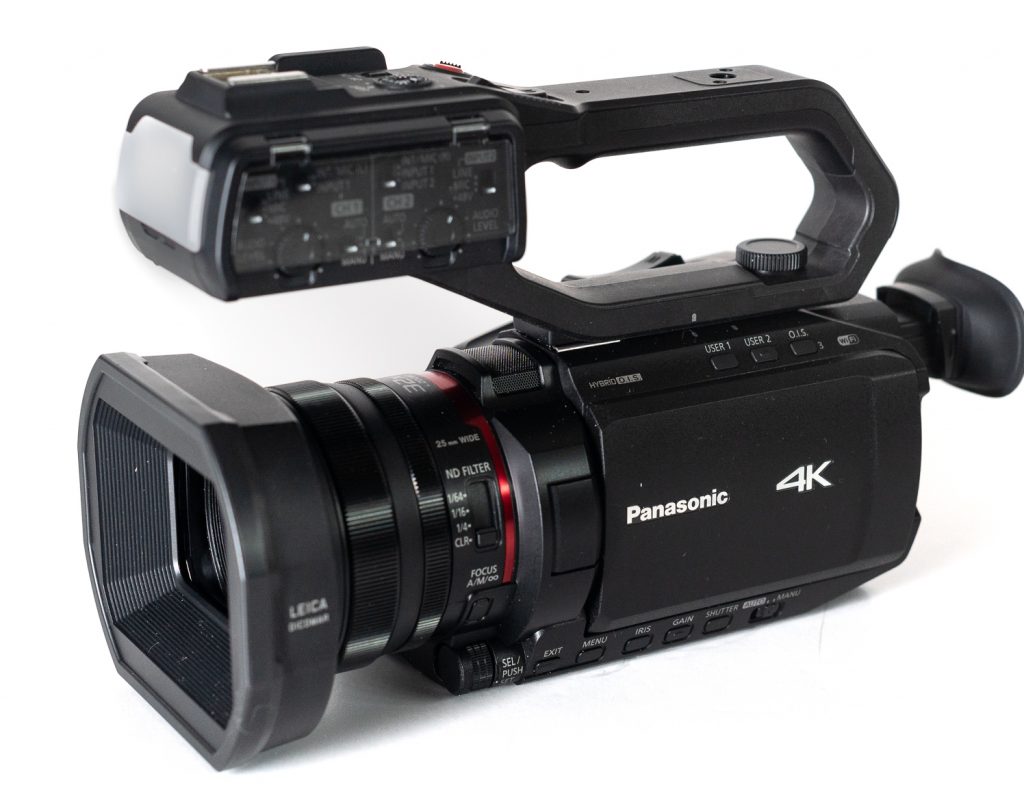If I were to be absolutely honest, my original thoughts about the Panasonic AG-CX10 4K Camcorder were, “Okay, a decent UHD camcorder.” But, and it is a big but, this admission percolated within my gray matter before the world went to shit. Now we Zoom, FaceTime, Skype, and whatever social distancing video conferencing app du jour you need to use. Our world has changed and what we need in a camera has changed too. 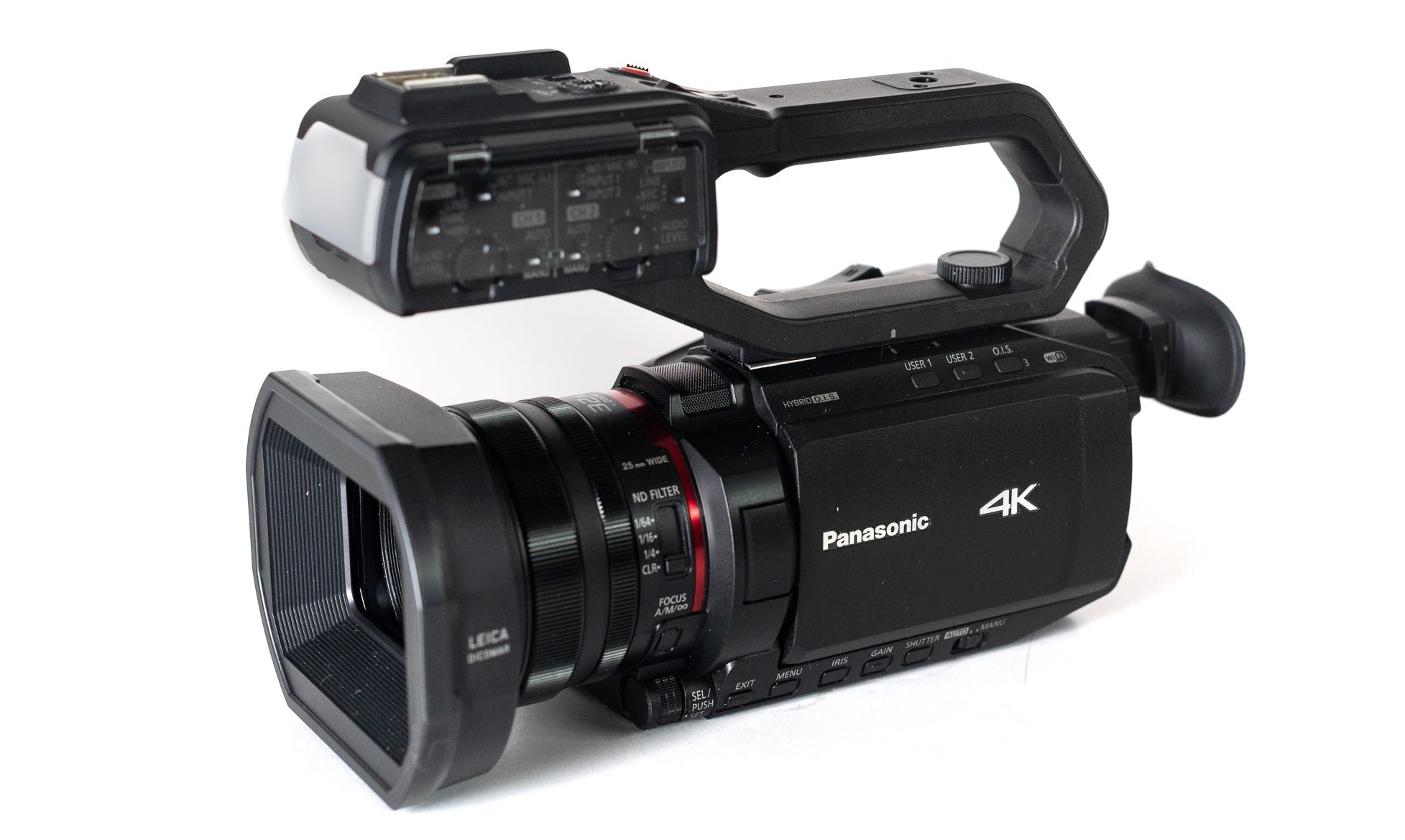
Let us head down to the goodness within the little camcorder, the Panasonic AG-CX10. First and foremost, the CX-10 includes IP Networking features, with Wi-Fi support for HD live streaming. See, suddenly, the little camcorder from Panasonic may have your attention. You can stream to Youtube, Facebook, and just about any website with video sharing, like say, Zoom. Just so you know, the CX-10 HD live streaming works via RTMP/RTMPS/RTSP protocols, or so I am told.
One may also use the Ethernet connection for streaming with the AG-CX10. These two features alone should, and now are, much sought after. With the AG-CX10, your Zoom can look professional. Your LiveStreaming on YouTube can look professional. Are you anchoring the news from home? Just plug in the Panasonic AG-CX10 to an Ethernet connection, and you are ready to go.
I’ll be frank with you for a moment. The Panasonic AG-CX10 looks a whole lot better than the built-in camera on your laptop, desktop, and, maybe, even your phone. I have vanity and ego as I guess you do too. My ego wants my Zoom video to be better than everyone else’s. My pride wants me to look great, whereas everyone else’s Zoom looks like a laptop camera shot it, which it did.
The Panasonic AG-CX10 is small but includes two professional XLR audio inputs. The top handle, well, handles all the audio. From inputs to dials, all your audio needs are in the top handle. The placement of the two XLR inputs is in a pretty standard spot for a camcorder. The addition of manual controls on the left side of the top handle helps to access what you need when you need it. See, professional XLR audio inputs and manual audio controls. The audio alone is way better than your internal laptop mic for that upcoming Zoom call. 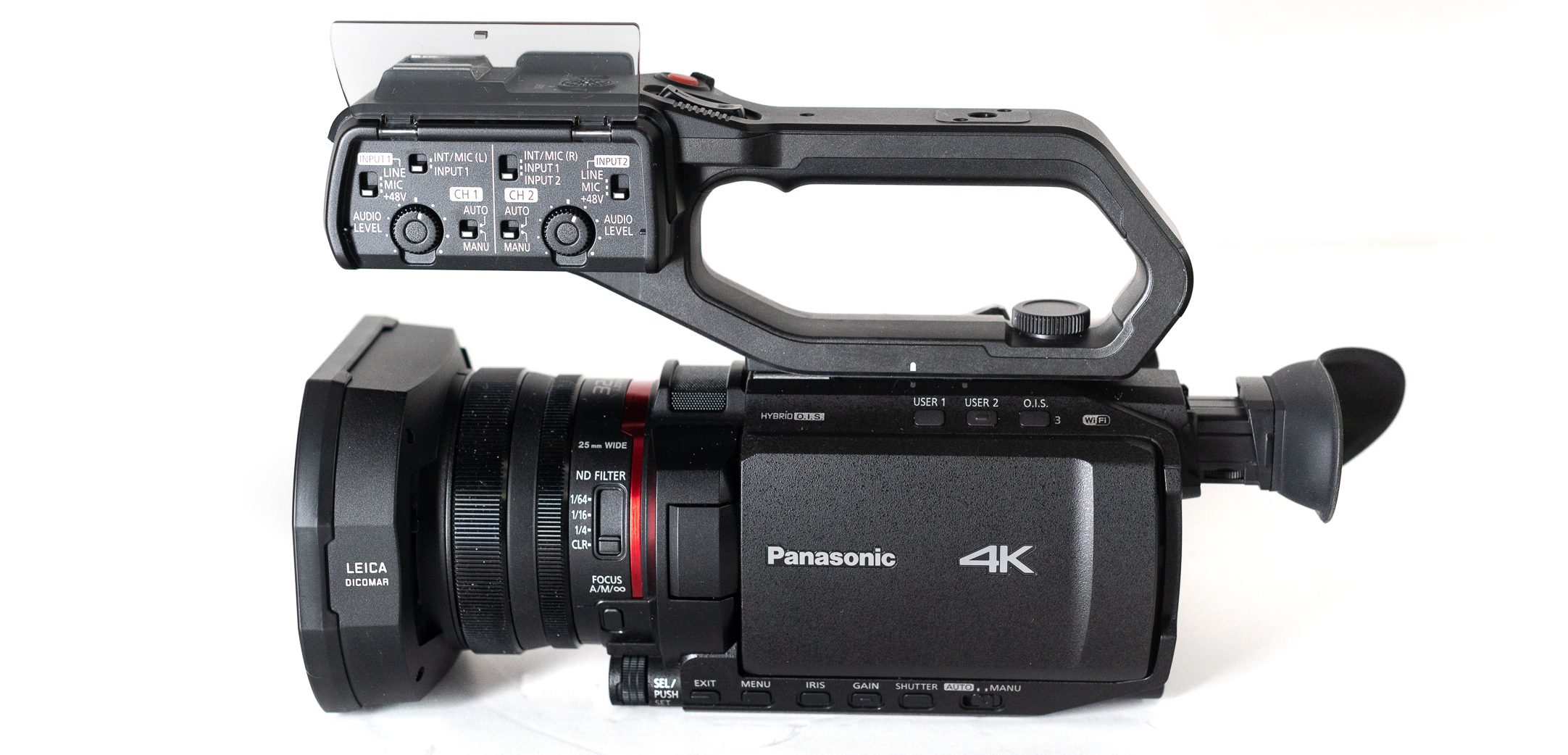
AG-CX10 Recording Options
The Panasonic AG-CX10 can record 4:2:2 10-bit UHD at 29.97 internally. To shoot 59.94p, you will need to drop the resolution down to FHD. I shot a ton of footage in UHD and FHD. You have a few different options for recording. I choose mp4 for some of my videos and HEVC( (LongGOP/10-bit 4:2:0/MOV) for 59.94p for others.
I did not have a microP2 card on hand for the specific P2 recording options, some of the settings required. I think some consumers who pick up the AG-CX10 will typically use a standard SD card, like I did, rather than a dedicated and more expensive microP2 card. If a business, like a local TV station, has the AG-CX10 on hand, then I expect the use of a microP2 in those cases. There are a lot of options for whatever you need.
I shot a bunch of UHD footage. Here I have a little sample of my daughter playing in the snow. The color profile setting used was Cine V which pushed some of the colors into an area of too much saturation. In DaVinci Resolve I was able to pull the over-saturated colors back into a legal range. I suggest to operators to choose either the Still color setting or Cine D for best color rendition. The UHD looks sharp and the image overall looks very close the original scene.
H.265/MOV 4:2:0 10-Bit:
- 3840 x 2160p at 50/59.94 fps (200 Mb/s VBR)
- 3840 x 2160p at 23.98/25/29.97 fps (150 Mb/s VBR)
MOV 4:2:2 10-Bit:
- 3840 x 2160p at 23.98/25/29.97 fps (150 Mb/s VBR)
- 1920 x 1080p at 25/29.97 fps (200 Mb/s VBR)
- 1920 x 1080p at 23.98/25/29.97/50/59.94 fps (100 Mb/s VBR)
- 1920 x 1080i at 50/59.94 fps (100 Mb/s VBR)
- 1920 x 1080i at 50/59.94 fps (50 Mb/s VBR)
- 1920 x 1080p at 23.98/29.97 fps (50 Mb/s VBR)
H.265/MP4 4:2:0 10-Bit:
- 3840 x 2160p at 50/59.94 fps (100 Mb/s VBR)
- 3840 x 2160p at 50/59.94 fps (72 Mb/s VBR)
MP4 4:2:0 8-Bit:
- 3840 x 2160p at 23.98/25/29.97 fps (72 Mb/s VBR)
- 1920 x 1080p at 23.98/50/59.94 fps (50 Mb/s VBR)
AVCHD 4:2:0 8-Bit:
- 1920 x 1080p at 50/59.94 fps (25 Mb/s VBR)
- 1920 x 1080i at 23.98/50/59.94 fps (21 Mb/s VBR)
- 1920 x 1080i at 50/59.94 fps (17 Mb/s VBR)
- 1280 x 720p at 50/59.94 fps (8 Mb/s VBR)
P2 4:2:2 10-Bit:
- 1920 x 1080p at 50/59.94 fps (50 Mb/s VBR)
- 1920 x 1080i at 50/59.94 fps (25 to 50 Mb/s VBR)
- 1280 x 720p at 50/59.94 fps (25 to 50 Mb/s VBR)
While the Panasonic AG-CX10 is not an especially low-light capable camera the noise in the UHD footage at higher ISO is not too bad. Take a little look at a little lens cap noise test I shot below.
Color Options
What elevates the Panasonic AG-CX10 is the different color profiles users may set internally. Users can find a handful of these color profiles on the menu. The settings range from a dedicated fluorescent color profile setting, which adds a bit of magenta to offset a green spike sometimes found in fluorescent lighting, to a cinema setting.
To see what color profiles I preferred, I shot a test video of a color chart. You can find this video below. I liked Cine D and the Still settings, because I thought the colors on the color chart looked the most accurate in these profiles. After all, the camera replicated those colors more accurately in a daylight setting. I accidentally had the AG-CX10 color profile set to fluorescent when I shot video of my daughter playing in the snow. The look of the video was a little too magenta but easily fixed in an NLE. 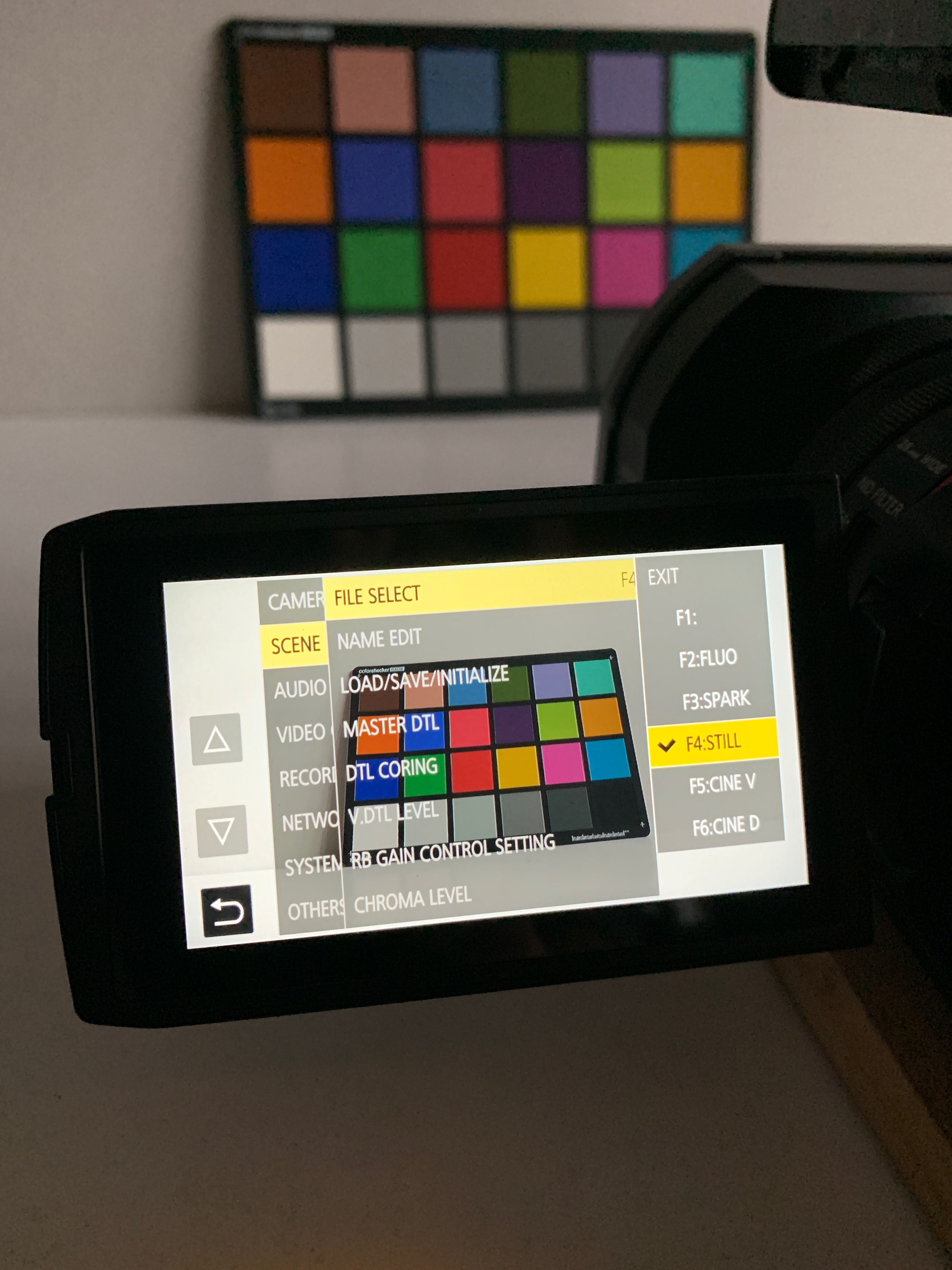
The LCD Screen and EVF
The 3.5″ fold-out LCD touchscreen is just big enough for tripod use and to flip back toward the camera subject to check the shot. Using the LCD screen outside, on a bright day, was a little harder. Under a hard summer sun, the 3.5″ LCD screen will be difficult to use. Thankfully the Panasonic AG-CX10 has an electronic viewfinder too. The LCD is also a touch screen, but I barely used it because I am more used to physical buttons and tend to use those options more because of habit. For those who prefer a touch screen, they will find the AG-CX10 has a pretty good one.
The EVF diopter was strong enough for me to use it without my glasses or contacts. I am very myopic and nearsighted. Being able to flip up my glasses to see into an EVF better is a massive plus for me. The image in the EVF felt like it looked similar to the image on the LCD monitor.
Autofocus
The Panasonic AG-CX10 is a camera meant for autofocus. In my review period with the AG-CX10, I tried to shoot with focus set to manual. I did not do a great job rolling focus. When I set the camera to autofocus, the camera was much easier to operate. More importantly, the AGCX-10 features a Face Detection AF mode allowing you to track faces automatically. The Face Detection AF mode really helped me keep my daughter in focus for some of my video tests. In those Zoom conference sessions, the Face Detection AF mode will help you keep you in focus, and I suggest using this setting for the best results. Manually setting the camera’s focus via the 3.5-inch LCD screen or EVF was not my favorite way to work. Plus, allow the tech of a camera to do the work for you.
Manual Lens Control Rings
The Panasonic AG-CX10 has two lens rings on the built-in lens. One of those rings is dedicated for focus and the other can go between zoom and iris control. I tended to prefer the second lens ring set to the iris instead of the zoom function. My main reasoning was this: the AG-CX10 has two rocker zoom controls on camera I used more often.
One of those rocker zoom controls in on the top handle and the other located precisely where one expects it, on the handgrip. The two rings are different sizes, allowing you to identify each ring by feel, so you don’t have to look away from the shot to confirm you are using the correct ring. An integrated ND wheel allows for the quick switching between a clear ND setting, 2-stop, 4-stop, and 6-stop NDs.
Built-In Top Light
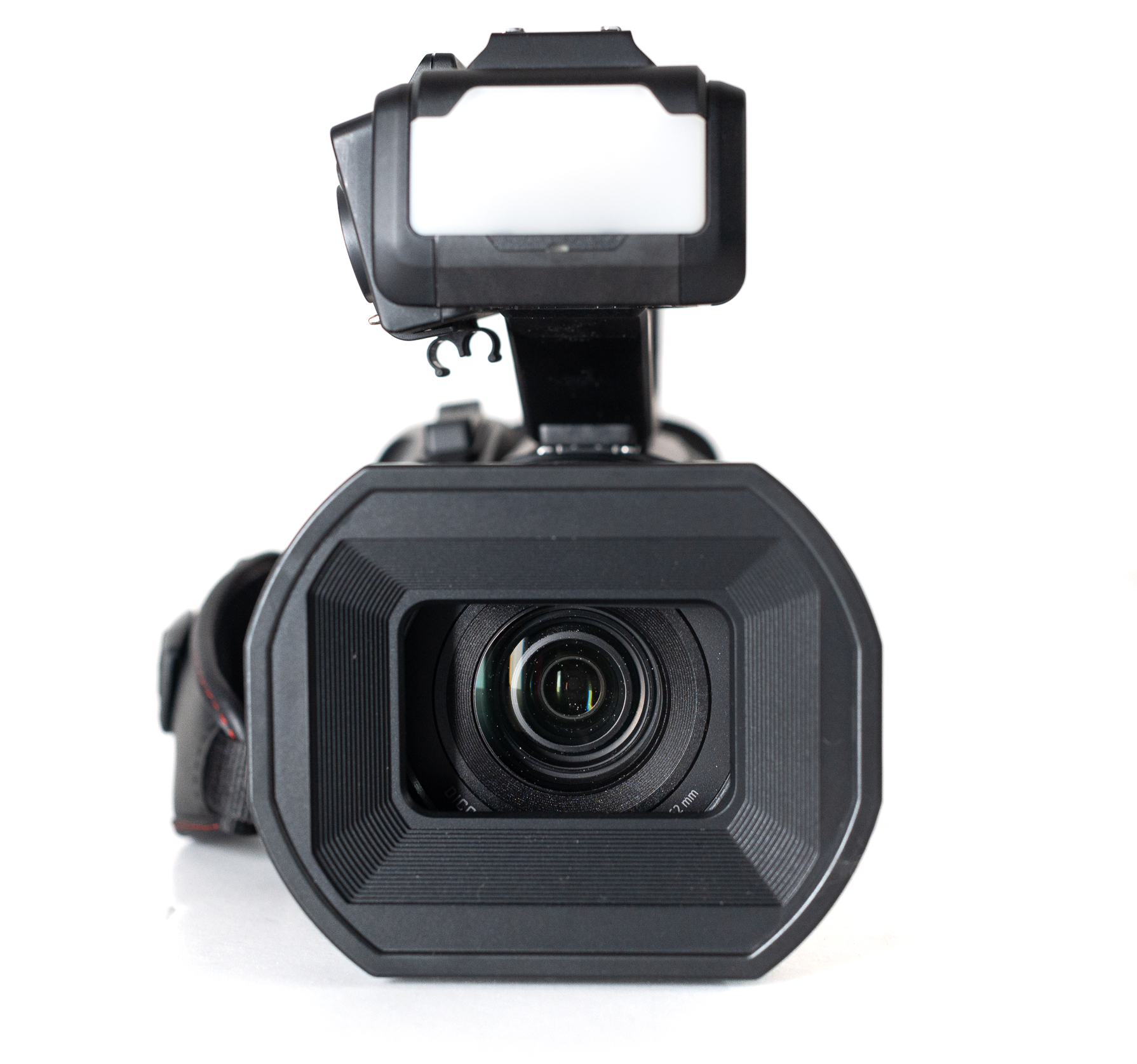
Before Coronavirus, this function seemed to be perfect for quick interviews where a top light is needed for exposure or as an eye-light. Now, the built-in top light, built into the CX-10’s top handle, is a good light for those Zoom sessions or any video conferencing program. In these Zoom situations, the top light works as a nice light to help you pop out from the background.
Image Stabilization
Stabilizing hand-held video has nearly become standard in little camcorders similar in size to the Panasonic AG-CX10. Whatever it takes to eliminate the eventual noticeable shakiness from the video is useful. In the case of the AG-CX10, the internal 5-axis optical image stabilization helped me achieve a slight floating feeling to my hand-held footage. If hand holding the Panasonic AG-CX10, then you should probably have the image stabilization on; otherwise, you will see every little movement.
All in the Panasonic AG-CX10 is a good little camcorder. The UHD recording is useful, but the ability to use the CX10 for live streaming seems to be the most significant current feature. The image is professional, and you can choose the color profile setting to achieve the best look for your video. I much preferred the flatter color profile with its more natural color rendition. Know this; the Panasonic AG-CX10 is a good camcorder with just enough of the necessary professional features to make use easy. The HD 10-bit files are smooth and color-rich, and I have a feeling one could pull a proper chroma key if needed.
Key Features
- Up to UHD 4K60 Video, 3G-SDI, HDMI Out
- NDI/HX for Streaming and IP Control
- 1/2.5″ 8.29M MOS Sensor, Venus Engine
- 24x Optical Zoom, 48x Digital iZoom
- Built-in top light
- 2 XLR inputs
- 3.5″ Flip-out Touchscreen
- 5-Axis Image Stabilization
- 2 Manual Lens Rings
- Face Detection AutoFocus Mode

Filmtools
Filmmakers go-to destination for pre-production, production & post production equipment!
Shop Now